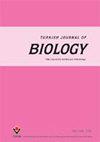甲基索洛酮诱导乳腺癌细胞和靶肿瘤干细胞群凋亡和氧化/内质网应激
IF 0.9
4区 生物学
Q3 BIOLOGY
引用次数: 0
摘要
乳腺癌是妇女中最常见的恶性肿瘤之一,也是癌症相关死亡的主要原因之一。乳腺癌需要新的治疗方法和药物。许多研究表明,由于三萜化合物及其半合成衍生物具有诱导细胞凋亡和抑制肿瘤发生的能力,它们作为抗癌药物具有很高的潜力。18- h -甘草次酸半合成衍生物甲基索罗洛酮(SM)对人乳腺癌细胞系(T-47D)和癌症干细胞(CSCs)群体(乳腺微球;CD44+/ cd24抗原)来源于乳腺癌细胞。ATP法测定SM的生长抑制作用。采用荧光染色、caspase-cleaved细胞角蛋白18和流式细胞术分析确定细胞死亡方式。此外,用Western Blotting和PCR分别在蛋白和基因水平上研究细胞死亡。SM通过产生ROS和内质网应激对2种模型的T-47D细胞产生时间和剂量依赖性的细胞毒性。磷脂酰丝氨酸暴露、caspase激活和bax过表达证明细胞死亡方式为凋亡。在乳腺球体作为3D模型中,SM降低了干细胞特性并诱导细胞死亡。综上所述,SM可能是一种很有前景的治疗乳腺癌的药物,特别是由于其对csc的抗生长活性。本文章由计算机程序翻译,如有差异,请以英文原文为准。
Soloxolone methyl induces apoptosis and oxidative/ER stress in breast cancer cells and target cancer stem cell population
One of the most prevalent malignancies in women and one of the leading causes of cancer-related death is breast cancer. There is a need for new treatment approaches and drugs for breast cancer. Many studies show the high potential of triterpene compounds and their semisynthetic derivatives as anticancer agents due to their ability to induce apoptosis and suppress tumorigenesis. The effects of soloxolone methyl (SM), a semisynthetic derivative of 18-H-glycyrrhetinic acid, on the cytotoxicity and apoptosis of human breast cancer cell line (T-47D) and cancer stem cell (CSCs) population (mammospheres; CD44+/CD24-antigen) derived from breast cancer cells, were examined in this work. The ATP assay was used to determine SM growth-inhibitory effects. Fluorescent staining, caspase-cleaved cytokeratin 18, and flow cytometry analysis were used to determine the mode of the cell death. In addition, cell death was investigated at protein and gene levels by Western Blotting and PCR, respectively. SM resulted in cytotoxicity in a time and dose dependent manner via ROS production and ER stress in T-47D cells in 2 models. The mode of cell death was apoptosis, evidenced by phosphatidylserine exposure, caspase activation, and bax overexpression. In mammospheres as 3D model, SM decreased stem cell properties and induced cell death. Taken together, SM may be a promising agent in the treatment of breast cancer, especially due to its antigrowth activity on CSCs.
求助全文
通过发布文献求助,成功后即可免费获取论文全文。
去求助
来源期刊

Turkish Journal of Biology
BIOLOGY-
CiteScore
4.60
自引率
0.00%
发文量
20
审稿时长
6-12 weeks
期刊介绍:
The Turkish Journal of Biology is published electronically 6 times a year by the Scientific and Technological
Research Council of Turkey (TÜBİTAK) and accepts English-language manuscripts concerning all kinds of biological
processes including biochemistry and biosynthesis, physiology and metabolism, molecular genetics, molecular biology,
genomics, proteomics, molecular farming, biotechnology/genetic transformation, nanobiotechnology, bioinformatics
and systems biology, cell and developmental biology, stem cell biology, and reproductive biology. Contribution is open
to researchers of all nationalities.
 求助内容:
求助内容: 应助结果提醒方式:
应助结果提醒方式:


